PTEROSPERMUM
Pterospermum
Schreb., Gen. Pl., ed. 8(a). 2: 461. 1791; Roxb., Fl. Ind. ed. Carey 3: 158. 1832; Benth. & Hook. f., Gen. Pl. 1: 21. 1862; Masters in Hook. f., Fl. Brit. Ind. 1: 366. 1875; Hutch., Gen. Fl. Pl. 2: 516. 1967; Fl. China @ eFloras.org 12: 327; Fl. Pak. @ eFloras.org p. 12.
Trees or shrubs, stellate velutinous or scurfy or scaly. Leaves simple; stipules linear to palmately fimbriate, sometimes forming nectaries, caducous; petioles short or long; leaf blade lobed or not, coppery, rusty or silvery beneath, leathery, base often oblique and peltate, margin entire or serrate, apex sometimes truncate, juvenile leaves sometimes much larger. Flowers actinomorphic, bisexual, pentamerous, hypogynous, large, 1-3 in axillary and terminal peduncles. Epicalyx (bracteoles) lobes usually 3, usually distinct from calyx, entire, fimbriate or palmately lobed, persistent, caducous, rarely absent. Calyx 5-lobed, divided nearly to base, nearly spreading or +/- reflexed, caducous. Petals 5, white or yellow, often obovate, oblong or linear, often erect, deciduous with calyx. Androgynophore present, very short, glabrous. Stamens 15, in 5 groups of 3 alternating with staminodes and opposite to sepals; filaments connate into staminal column (column adnate to gynophore forming androgynophore), free at top; anthers linear/ oblong, bithecous, thecae parallel, connective apiculate; staminodes 5, filiform, longer and thicker than filaments. Carpels usually 5, syncarpous; ovary inserted at top of androgynophore, 5-locular, 4-22 ovules per loculus; style entire, clavate or filiform; stigma longitudinally 5-furrowed. Fruit a schizocarp, cylindric or ovoid, angular or rounded, usually woody, sometimes leathery, dehiscent into 5-loculicidal valves when mature. Seeds 2-many per valve, attached in 2 rows to the inner angle of locule, seeds winged above, wing single, long, oblong, membranous; endosperm scanty or absent. Cotyledons usually plicate.
10 species
Pterospermum acerifolium
Pterospermum acerifolium
(L.) Willd., Sp. Pl. 3: 729. 1801; Masters in Hook. f., Fl. Brit. India 1: 368. 1875; Brandis, Ind. Trees, 91. 1906; Talbot, For. Fl. Bomb. Pres. and Sind, 1: 149. 1909; L. H. Bailey, Stand. Cyclop. Hort. 1: 2855. 1917; Parker, For. Fl. Punj. ed. 1: 46. 1918 (Reprint 1973); Cowen, Fl. Trees & Shrubs Ind. 81. 1969; Fl. China @ eFloras.org 12; Fl. Pak. @ eFloras.org p. 12; Cavanilla acerifolia (L.) J. F. Gmel., Syst. Nat. 1937. 1792; Dombeya acerifolia (L.) Gaertn., Fruct. Sem. Pl. 2: 260. 1791; Pentapetes acerifolia L., Sp. Pl. 698. 1753; Pterospermadendron acerifolium (L.) Kuntze, Revis. Gen. Pl. 1: 80. 1891.
A large evergreen tree, 12-15 m tall with smooth grey bark. Younger branches and inflorescence clothed with ferruginous (rusty) tomentum. Leaves alternate, stipulate, petiolate. Stipules multifid, caducous. Petiole 5-25 cm long, densely tomentose, pulvinate at base; leaf blade 15-35 cm x 12-29 cm, ovate, obovate to orbicular, often peltate at base, sinuately lobed, entire or remotely toothed, leathery, glabrous, dark green above, grey- tomentose beneath, palmately 7-9-nerved, lateral nerves 4-6 pairs. Flowers 1-3 together on short peduncle, axillary, actinomorphic, bisexual, pentamerous, hypogynous, fragrant, white, 10-15 cm long and 12-15 cm across; bracts ca. 3 cm long, pubescence like calyx, multifid or laciniate; pedicel ca. 2 cm long. Sepals 5, connate at base, fleshy, segments linear, revolute, 8-12 cm x 0.7-1 cm, abaxially densely rusty- stellate, pubescent or velutinous, adaxially white villous, reflexed. Petals 5, free, linear-oblong, obovate or obliquely cuneate, revolute, slightly shorter than calyx, 6-12 cm x ca. 1 cm, reflexed, obtuse, deciduous with calyx. Staminal column tubular, 2-3 cm long, adnate to gynophore (forming androgynophore), bearing 15 stamens alternating in threes with 5 staminodes, fertile stamens 5-9 cm long; anthers linear, 1-1.5 cm long; staminodes ca. 1.5 cm long, longer than stamens (nearly equalling petals), apex clavate. Carpels 5, syncarpous; ovary inserted on top of androgynophore, 1-3 cm long, oblong, pentagonal, densely rusty tomentose, 5-locular, each loculus with many ovules ( 12-20); style ca. 5 cm long, tomentose in lower half; stigma clavate. Fruit a capsule, 10-20 cm x 3-6 cm, oblong, woody, 5-angled, brown tomentose without, dehiscent into 5 loculicidal valves when mature. Seeds many per valve, attached in 2 rows to the inner angle of the valve. Seeds rhombic or obliquely ovoid, 1-2 cm x 1-1.5 cm, compressed, with one large, thin, membranous wing, 3.2-4 cm x 1.3-1.4 cm.
Common Names: Bayur Tree, Dinner Plate Tree, Karnikara Tree, Maple-leaved Bayur Tree, Torch Tree: Kanak Champa, Padma Pushp, Parivyadh, Muchkund (Hindi)
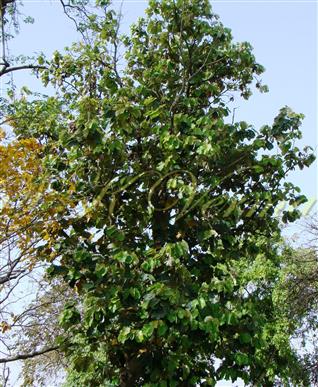
-5173.jpg)
-5174.jpg)
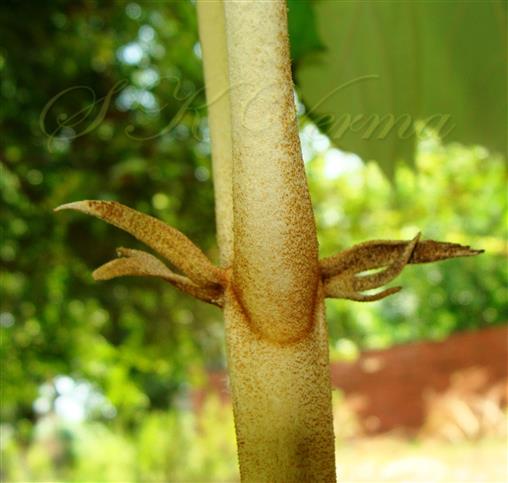
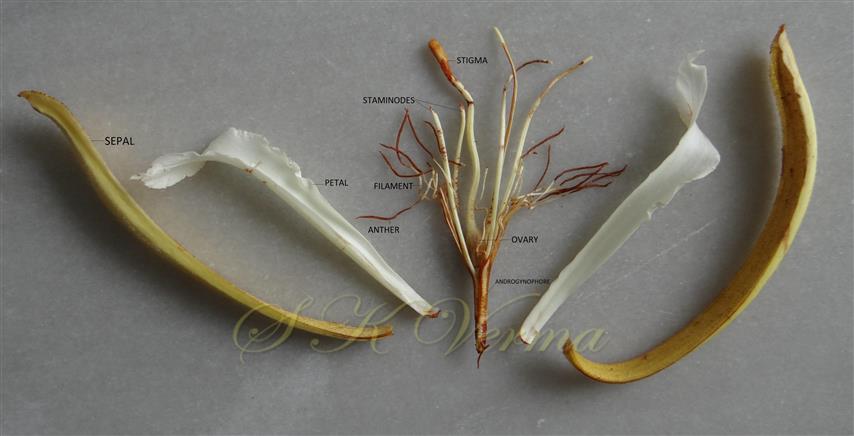
-DSC07387.jpg)
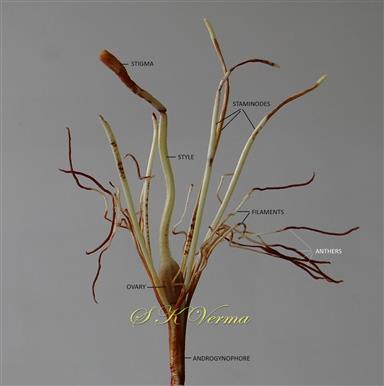
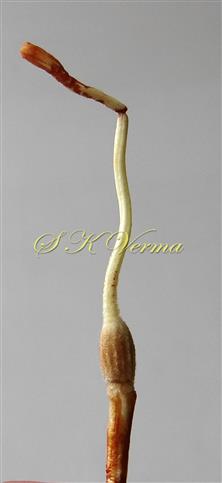

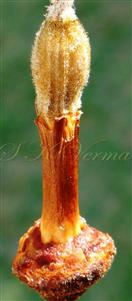
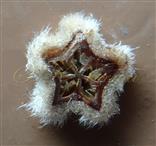
-5193.jpg)
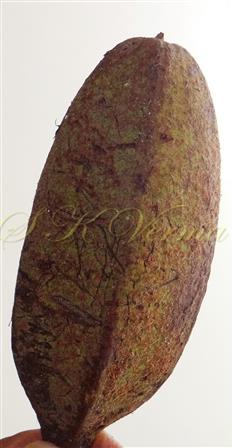
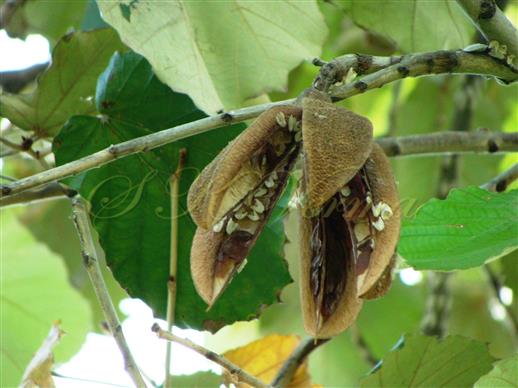
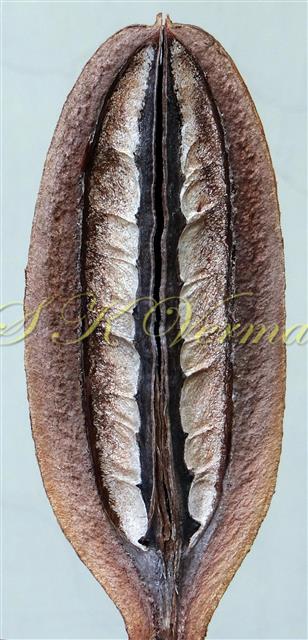
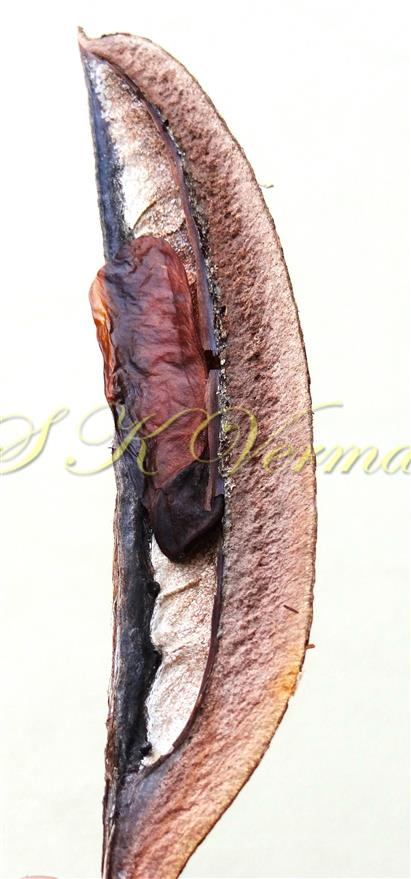
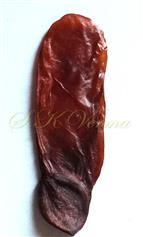


-5173.jpg)
-5174.jpg)


-DSC07387.jpg)





-5193.jpg)




